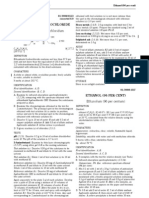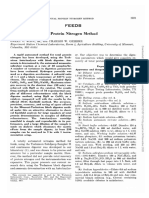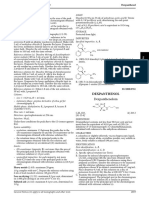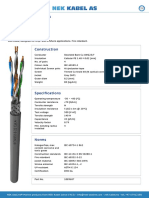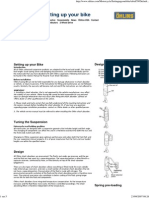0 ratings0% found this document useful (0 votes)
Asam
Asam
Uploaded by
dewiThis document provides the method for determining the content of 2-ethylhexanoic acid in samples. It involves the following steps:
1. Digesting the sample using microwave digestion. This breaks down the sample into simpler compounds.
2. Measuring the levels of various metals like cadmium, copper, iron, lead, nickel, zinc, arsenic, and mercury using atomic absorption spectroscopy with standards.
3. Analyzing the digested sample using gas chromatography with an internal standard. Comparing the results to a reference standard to calculate the percentage of 2-ethylhexanoic acid.
Copyright:
© All Rights Reserved
Available Formats
Download as PDF, TXT or read online from Scribd
Download as pdf or txt
Asam
Asam
Uploaded by
dewi0 ratings0% found this document useful (0 votes)
This document provides the method for determining the content of 2-ethylhexanoic acid in samples. It involves the following steps:
1. Digesting the sample using microwave digestion. This breaks down the sample into simpler compounds.
2. Measuring the levels of various metals like cadmium, copper, iron, lead, nickel, zinc, arsenic, and mercury using atomic absorption spectroscopy with standards.
3. Analyzing the digested sample using gas chromatography with an internal standard. Comparing the results to a reference standard to calculate the percentage of 2-ethylhexanoic acid.
Original Title
asam
Copyright
© © All Rights Reserved
Available Formats
PDF, TXT or read online from Scribd
Share this document
Did you find this document useful?
Is this content inappropriate?
This document provides the method for determining the content of 2-ethylhexanoic acid in samples. It involves the following steps:
1. Digesting the sample using microwave digestion. This breaks down the sample into simpler compounds.
2. Measuring the levels of various metals like cadmium, copper, iron, lead, nickel, zinc, arsenic, and mercury using atomic absorption spectroscopy with standards.
3. Analyzing the digested sample using gas chromatography with an internal standard. Comparing the results to a reference standard to calculate the percentage of 2-ethylhexanoic acid.
Copyright:
© All Rights Reserved
Available Formats
Download as PDF, TXT or read online from Scribd
Download as pdf or txt
0 ratings0% found this document useful (0 votes)
Asam
Asam
Uploaded by
dewiThis document provides the method for determining the content of 2-ethylhexanoic acid in samples. It involves the following steps:
1. Digesting the sample using microwave digestion. This breaks down the sample into simpler compounds.
2. Measuring the levels of various metals like cadmium, copper, iron, lead, nickel, zinc, arsenic, and mercury using atomic absorption spectroscopy with standards.
3. Analyzing the digested sample using gas chromatography with an internal standard. Comparing the results to a reference standard to calculate the percentage of 2-ethylhexanoic acid.
Copyright:
© All Rights Reserved
Available Formats
Download as PDF, TXT or read online from Scribd
Download as pdf or txt
You are on page 1/ 2
2.4.28. 2-Ethylhexanoic acid EUROPEAN PHARMACOPOEIA 5.
METHOD stand at room temperature for about 50 min or at 70 °C for
about 4 min.
In case alternative apparatus is used, an adjustment of the
instrument parameters may be necessary. Acid reagent. Heavy metal-free hydrochloric acid R.
Clean all the glassware and laboratory equipment with a Reducing reagent. A 6 g/l solution of sodium
10 g/l solution of nitric acid R before use. tetrahydroborate R in a 5 g/l solution of sodium
hydroxide R.
Test solution. In a digestion flask place the prescribed The instrumental parameters in Table 2.4.27.-2 may be used.
quantity of the substance to be examined (about 0.50 g of
powdered drug (1400) or 0.50 g of fatty oil). Add 6 ml of Mercury
heavy metal-free nitric acid R and 4 ml of heavy metal-free Sample solution. Test solution or blank solution, as
hydrochloric acid R. Make the flask airtight. prescribed above.
Place the digestion flasks in the microwave oven. Carry Acid reagent. A 515 g/l solution of heavy metal-free
out the digestion in 3 steps according to the following hydrochloric acid R.
programme, used for 7 flasks each containing the test Reducing reagent. A 10 g/l solution of stannous chloride R
solution : 80 per cent power for 15 min, 100 per cent power in dilute heavy metal-free hydrochloric acid R.
for 5 min, 80 per cent power for 20 min.
The instrumental parameters in Table 2.4.27.-2 may be used.
At the end of the cycle allow the flasks to cool in air and to
each add 4 ml of heavy metal-free sulphuric acid R. Repeat Table 2.4.27.-2
the digestion programme. After cooling in air, open each As Hg
digestion flask and introduce the clear, colourless solution
obtained into a 50 ml volumetric flask. Rinse each digestion Wavelength nm 193.7 253.7
flask with 2 quantities, each of 15 ml, of water R and collect Slit width nm 0.2 0.5
the rinsings in the volumetric flask. Add 1.0 ml of a 10 g/l
solution of magnesium nitrate R and 1.0 ml of a 100 g/l Lamp current mA 10 4
solution of ammonium dihydrogen phosphate R and dilute Acid reagent flow rate ml/min 1.0 1.0
to 50.0 ml with water R.
Reducing reagent flow rate ml/min 1.0 1.0
Blank solution. Mix 6 ml of heavy metal-free nitric acid R Sample solution flow rate ml/min 7.0 7.0
and 4 ml of heavy metal-free hydrochloric acid R in a
digestion flask. Carry out the digestion in the same manner Absorption cell Quartz Quartz
as for the test solution. (heated) (unheated)
Background corrector off off
CADMIUM, COPPER, IRON, LEAD, NICKEL AND ZINC
Measure the content of cadmium, copper, iron, lead, Nitrogen flow rate l/min 0.1 0.1
nickel and zinc by the standard additions method (2.2.23,
Method II), using reference solutions of each heavy metal
and the instrumental parameters described in Table 2.4.27.-1.
The absorbance value of the blank solution is automatically 01/2005:20428
subtracted from the value obtained with the test solution.
Table 2.4.27.-1 2.4.28. 2-ETHYLHEXANOIC ACID
Cd Cu Fe Ni Pb ZnExamine by gas chromatography (2.2.28), using
Wavelength nm 228.8 324.8 248.3 232 283.5 3-cyclohexylpropionic acid R as the internal standard.
213.9
Slit width nm 0.5 0.5 0.2 0.2 0.5 0.5 Internal standard solution. Dissolve 100 mg of
3-cyclohexylpropionic acid R in cyclohexane R and dilute
Lamp current mA 6 7 5 10 5 7 to 100 ml with the same solvent.
Ignition °C 800 800 800 800 800 800 Test solution. To 0.300 g of the substance to be examined,
temperature
add 4.0 ml of a 33 per cent V/V solution of hydrochloric
Atomisation °C 1800 2300 2300 2500 2200 2000
temperature acid R. Shake vigorously for 1 min with 1.0 ml of the internal
Background on off off off off off standard solution. Allow the phases to separate (if necessary,
corrector centrifuge for a better separation). Use the upper layer.
Nitrogen flow l/min 3 3 3 3 3 3 Reference solution. Dissolve 75.0 mg of 2-ethylhexanoic
acid R in the internal standard solution and dilute to 50.0 ml
ARSENIC AND MERCURY with the same solution. To 1.0 ml of the solution add 4.0 ml
Measure the content of arsenic and mercury in comparison of a 33 per cent V/V solution of hydrochloric acid R.
with the reference solutions of arsenic or mercury at a known Shake vigorously for 1 min. Allow the phases to separate (if
concentration by direct calibration (2.2.23, Method I) using necessary, centrifuge for a better separation). Use the upper
an automated continuous-flow hydride vapour generation layer.
system. The chromatographic procedure may be carried out using :
The absorbance value of the blank solution is automatically — a wide-bore fused-silica column 10 m long and 0.53 mm
subtracted from the value obtained with the test solution. in internal diameter coated with macrogol 20 000
Arsenic 2-nitroterephthalate R (film thickness 1.0 µm),
Sample solution. To 19.0 ml of the test solution or of the — helium for chromatography R as the carrier gas at a flow
blank solution as prescribed above, add 1 ml of a 200 g/l rate of 10 ml/min,
solution of potassium iodide R. Allow the test solution to — a flame-ionisation detector,
120 See the information section on general monographs (cover pages)
EUROPEAN PHARMACOPOEIA 5.0 2.4.29. Composition of fatty acids in oils rich in omega-3-acids
with the following temperature programme : Test solution (a)
Time Temperature Rate Comment
A. Dissolve the mass of sample to be examined according
(min) (°C) (°C/min)
to Table 2.4.29.-1 and about 70.0 mg of the internal
– standard in a 50 mg/l solution of butylhydroxytoluene R
Column 0-2 40 isothermal
in trimethylpentane R and dilute to 10.0 ml with the
2 - 7.3 40 → 200 30 linear gradient same solution.
7.3 - 10.3 200 – isothermal Table 2.4.29.-1.
Injection port 200 Approximative sum EPA + DHA Amount sample to be weighed
Detector 300 (per cent) (grams)
30 - 50 0.4 - 0.5
Inject 1 µl of the test solution and 1 µl of the reference 50 - 70 0.3
solution.
70 - 90 0.25
The test is not valid unless the resolution between the peaks
corresponding to 2-ethylhexanoic acid (first peak) and the Ethyl esters are now ready for analysis. For triglycerides
internal standard is at least 2.0. continue as described in step B.
Calculate the percentage content of 2-ethylhexanoic acid B. Introduce 2.0 ml of the solution obtained into a quartz
from the expression : tube and evaporate the solvent with a gentle current of
nitrogen R. Add 1.5 ml of a 20 g/l solution of sodium
hydroxide R in methanol R, cover with nitrogen R,
cap tightly with a polytetrafluoroethylene-lined cap,
mix and heat on a water-bath for 7 min. Allow to cool.
AT = area of the peak corresponding to 2-ethylhexanoic Add 2 ml of boron trichloride-methanol solution R,
acid in the chromatogram obtained with the test cover with nitrogen R, cap tightly, mix and heat on a
solution, water-bath for 30 min. Cool to 40-50 °C, add 1 ml of
AR = area of the peak corresponding to 2-ethylhexanoic trimethylpentane R, cap and shake vigorously for at
acid in the chromatogram obtained with the least 30 s. Immediately add 5 ml of a saturated sodium
reference solution, chloride solution R, cover with nitrogen R, cap and shake
thoroughly for at least 15 s. Transfer the upper layer to
IT = area of the peak corresponding to the internal a separate tube. Shake the methanol layer once more
standard in the chromatogram obtained with the with 1 ml of trimethylpentane R. Wash the combined
test solution, trimethylpentane extracts with 2 quantities, each of 1 ml,
IR = area of the peak corresponding to the internal of water R and dry over anhydrous sodium sulphate R.
standard in the chromatogram obtained with the Prepare 3 solutions for each sample.
reference solution, Test solution (b). Dissolve 0.300 g of the sample to be
mT = mass of the substance to be examined in the test examined in a 50 mg/l solution of butylhydroxytoluene R
solution, in grams, in trimethylpentane R and dilute to 10.0 ml with the same
solution. Proceed as described for test solution (a).
mR = mass of 2-ethylhexanoic acid in the reference
Reference solution (a). Dissolve 60.0 mg of docosahexaenoic
solution, in grams. acid ethyl ester CRS, about 70.0 mg of the internal standard
and 90.0 mg of eicosapentaenoic acid ethyl ester CRS
in a 50 mg/l solution of butylhydroxytoluene R in
trimethylpentane R and dilute to 10.0 ml with the same
01/2005:20429 solution. Proceed as described for test solution (a) step A
when analysing ethyl esters. For analysis of triglycerides,
continue with step B in the same manner as for test
2.4.29. COMPOSITION OF solution (a). Prepare 3 solutions for each sample.
FATTY ACIDS IN OILS RICH IN Reference solution (b). Into a 10 ml volumetric flask
dissolve 0.3 g of methyl palmitate R, 0.3 g of methyl
OMEGA-3-ACIDS stearate R, 0.3 g of methyl arachidate R and 0.3 g of methyl
The assay may be used for quantitative determination of behenate R, in a 50 mg/l solution of butylhydroxytoluene R
the EPA and DHA content in omega-3-containing products in trimethylpentane R and dilute to 10.0 ml with the same
of fish oil in different concentrations. The method is solution.
applicable to triglycerides or ethyl esters and the results are Reference solution (c). Into a 10 ml volumetric
expressed as triglycerides or ethyl esters, respectively. flask dissolve a sample containing about 55.0 mg of
docosahexaenoic acid methyl ester R and about 5.0 mg of
EPA AND DHA tetracos-15-enoic acid methyl ester R in a 50 mg/l solution
of butylhydroxytoluene R in trimethylpentane R and dilute
Gas chromatography (2.2.28). Carry out the operations
to 10.0 ml with the same solution.
as rapidly as possible, avoiding exposure to actinic light,
oxidising agents, oxidation catalysts (for example, copper Column :
and iron) and air. — material : fused silica,
The assay is carried out on the methyl or ethyl esters of — dimensions : l = at least 25 m, Ø = 0.25 mm,
(all-Z)-eicosa-5,8,11,14,17-pentaenoic acid (EPA ; 20:5 n-3) — stationary phase : bonded macrogol 20 000 R (film
and (all-Z)-docosa-4,7,10,13,16,19-hexaenoic acid (DHA ; 22:6 thickness 0.2 µm).
n-3) in the substance to be examined. Carrier gas : hydrogen for chromatography R or helium
Internal standard. Methyl tricosanoate R. for chromatography R.
General Notices (1) apply to all monographs and other texts 121
You might also like
- PH Eur 2.4.27. Heavy Metals in Herbal Drugs and Fatty OilsNo ratings yetPH Eur 2.4.27. Heavy Metals in Herbal Drugs and Fatty Oils2 pages
- 2.4.27. Heavy metals in herbal drugs and herbal drug preparationsNo ratings yet2.4.27. Heavy metals in herbal drugs and herbal drug preparations3 pages
- EP 9.2-Copper Tetramibi Tetrafluoroborate For Radiopharmaceutical PreparationsNo ratings yetEP 9.2-Copper Tetramibi Tetrafluoroborate For Radiopharmaceutical Preparations1 page
- 2.4.29. Composition of Fatty Acids in Oils Rich in Omega-3 AcidsNo ratings yet2.4.29. Composition of Fatty Acids in Oils Rich in Omega-3 Acids3 pages
- Is.13228.2006 Corrugated Box Technology-11-19No ratings yetIs.13228.2006 Corrugated Box Technology-11-199 pages
- Feeds An Automated Total Protein Nitrogen Method: Apparatus and ReagentsNo ratings yetFeeds An Automated Total Protein Nitrogen Method: Apparatus and Reagents6 pages
- Hexanes: Chemical Names Chemical Formula Formula WeightNo ratings yetHexanes: Chemical Names Chemical Formula Formula Weight6 pages
- Esomeprazole Magnesium Dihydrate EP 11.0No ratings yetEsomeprazole Magnesium Dihydrate EP 11.03 pages
- EPA Method - 206 - 2 - Arsenic AA - Furnace TechniqueNo ratings yetEPA Method - 206 - 2 - Arsenic AA - Furnace Technique2 pages
- USP EP - 2.4.13 - Sulfates, 2.4.16 - Total AshNo ratings yetUSP EP - 2.4.13 - Sulfates, 2.4.16 - Total Ash1 page
- The Chemistry of Fertilisers and Manure - Including Information on the Chemical Constituents and Types of Fertilisers and ManuresFrom EverandThe Chemistry of Fertilisers and Manure - Including Information on the Chemical Constituents and Types of Fertilisers and Manures5/5 (1)
- RoutledgeHandbooks 9781420084832 Chapter231No ratings yetRoutledgeHandbooks 9781420084832 Chapter2318 pages
- Environmental Aspects of Inorganic Tin ChemREV1No ratings yetEnvironmental Aspects of Inorganic Tin ChemREV17 pages
- Evaluating Measurement Uncertainty in Clinical ChemistryNo ratings yetEvaluating Measurement Uncertainty in Clinical Chemistry46 pages
- Determination Measurement UncertaintY 1 6 14No ratings yetDetermination Measurement UncertaintY 1 6 147 pages
- Calibration ISO IEC 17025 Annex Temperature MetrologyNo ratings yetCalibration ISO IEC 17025 Annex Temperature Metrology15 pages
- CALSYS1200LBB Evaluation Report 1200LER05No ratings yetCALSYS1200LBB Evaluation Report 1200LER055 pages
- Coordination Insertion Mechanism of Ring Opening Polymerization of Lactide Catalyzed by Stannous OctoateNo ratings yetCoordination Insertion Mechanism of Ring Opening Polymerization of Lactide Catalyzed by Stannous Octoate12 pages
- Pages From Rules of Thumb For Chemical Engineers, 4th EdNo ratings yetPages From Rules of Thumb For Chemical Engineers, 4th Ed10 pages
- Specification AND Bill of Quantities: FDRE Ministry of National DefenceNo ratings yetSpecification AND Bill of Quantities: FDRE Ministry of National Defence31 pages
- PSIC - Final of Domestic Electrical AppliancesNo ratings yetPSIC - Final of Domestic Electrical Appliances82 pages
- United States Patent (19) 11 Patent Number: 5,315,939No ratings yetUnited States Patent (19) 11 Patent Number: 5,315,93928 pages
- ACS880-04 Drive Modules (200 To 710 KW, 300 To 700 HP) : Quick Installation GuideNo ratings yetACS880-04 Drive Modules (200 To 710 KW, 300 To 700 HP) : Quick Installation Guide92 pages
- ANSI/AIHA Ventilation Standards - " A Consensus ApproachNo ratings yetANSI/AIHA Ventilation Standards - " A Consensus Approach132 pages
- T Strainers Ludemann Installation Operations and Maintenance ManualNo ratings yetT Strainers Ludemann Installation Operations and Maintenance Manual7 pages
- 9.8 Iron Extraction Steel Making Set 2 QP MsNo ratings yet9.8 Iron Extraction Steel Making Set 2 QP Ms10 pages
- Estimations of Water Supply and Sanitary Works .0% (1)Estimations of Water Supply and Sanitary Works .2 pages








